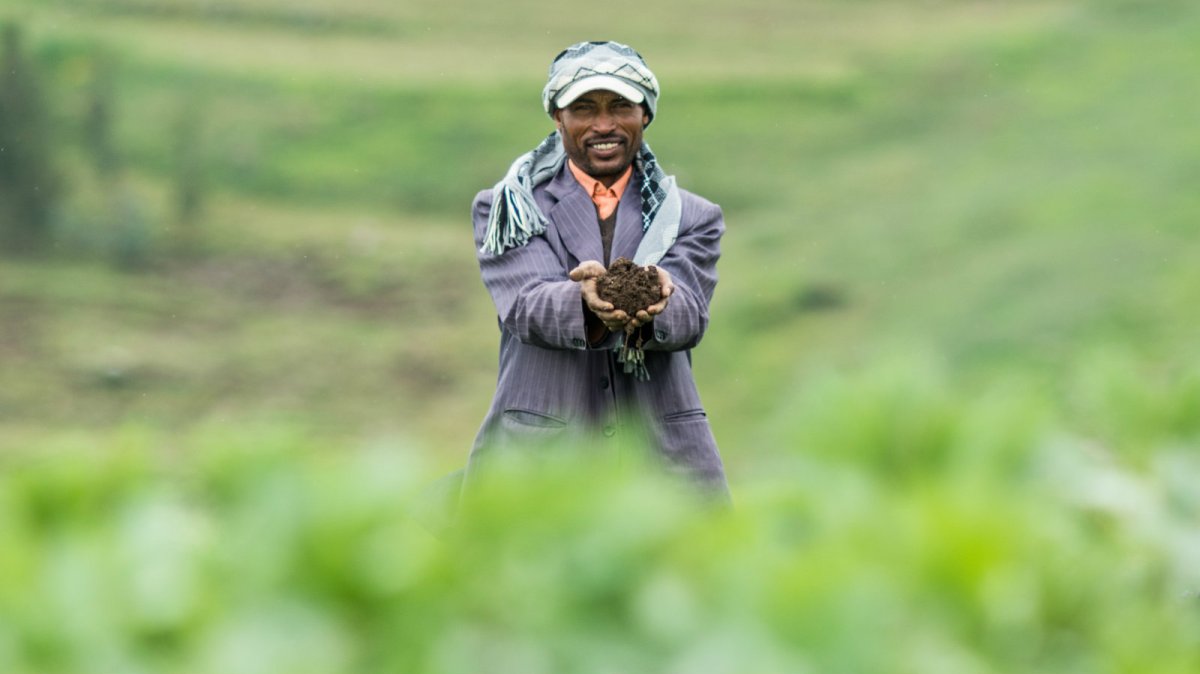Originally an EiB Op-Ed published on Farming First.
Crop breeding is helping farmers in the developing world produce higher yields and better products under increasingly harsh conditions. This World Soil Day, Breeding Resource Initiative / EiB's phenotypinga and breeding operations expert Gustavo Teixeira, explores how breeding success is inextricably linked to how we address soil degradation.

There is a growing crisis beneath our feet. Scientists, soil specialists and policy-makers around the world are sounding the alarm about degrading soil conditions. And it is particularly stark in developing countries. In fact, about 40 per cent of soils in sub-Saharan Africa are already of poor quality.
Declining soil health causes poor crop yields, leading to further pressure on the soils as farmers struggle to meet food demands and eke out a living. Many farmers lack access to information or technologies to get out of this vicious cycle. If you are a farmer with the need to increase your yield in the face of these challenges, crop breeding and soil management offers a range of solutions as part of an Integrated Soil Fertility Management (ISFM) approach.
For instance, breeding programs which partner with CGIAR Excellence in Breeding (EiB) are working to deliver the best seed varieties for farmers to help them withstand harsh conditions and increase yields. Alongside this work, researchers are supporting farmers to adopt better agronomic practices, such as minimum tillage farming, crop rotation, proper spacing and planting date practices, the use of terracing or intercropping, or techniques to reduce water use.
Of course, breeding cannot happen in a vacuum. To protect soils and produce quality yields, these cropping measures should be closely matched to the best, context-appropriate soil management practices available to farmers, for instance around the type and timing of mineral fertilizer, along with organic sources like crop residues, compost or manure.
Indeed, a combination will bring the best results. But most of the time accessing either improved variety or best agronomic practice represent a challenge for farmers in low income countries.
Here are three ways crop breeders can ensure they deliver the best seeds and create the best conditions for long-term crop production.

A man inspects a drought-tolerant bean plant on a trial site in Malawi. (Photo: Neil Palmer/CIAT)
1. Include farmers, agronomic experts and extension services when defining product requirements
Strong connections among public breeding programs and extension and agronomic groups are vital. There is growing discussion regarding how to broaden our work to better consider all of the factors that contribute to a successful breeding scheme: genotyping, environment and management (GxExM). However, defining the management component is not easy. Do we breed for conditions that farmers are actually working with, or breed for conditions that they should adopt?
A key to answer this question is a strong breeding team defining the traits needed and wanted by farmers. To design the best product profile, it is imperative to involve extension teams and other groups that work on the development of sustainable agronomic practices.
2. Properly manage research stations
Attention also needs to focus on the sustainability practices within research stations. It is all too easy to find degraded soil in public research stations. There are many reasons for this: inadequate long-term planning, lack of organized management structures, insufficient connections between breeding and agronomic teams, and lack of resources, to name a few.
Public research stations must serve as an example for the farmers in that specific region. Thus, it is not only what products we develop that matters, but also how we develop them. If we develop a good variety at the research station, but do so without adopting good agronomic practice, what example has been set for farmers and future generations? We need to ensure we invest in the best soil management practices along every step of the research phase.
3. Breed for specific soil characteristics
Once the breeding target is known, breeding for specific soil conditions is critical. This means developing varieties for soil conditions such as nutrient deficiencies or high salinity levels. CGIAR breeding programs have put in tremendous efforts with great impact here.
For example, AfricaRice and partners developed rice varieties branded ARICA (Advanced Rice Varieties for Africa) to be salt or iron toxicity tolerant, among other traits. This is helping farmers who farm under predominantly rainfed conditions, in which soils and yields are threatened by floods, droughts and toxicity.
Another standout product is Stress Tolerant Maize for Africa, led by the International Maize and Wheat Improvement Center (CIMMYT) and the International Institute of Tropical Agriculture (IITA). Breeders have developed varieties that can thrive in low soil fertility conditions, along with resistance to other stresses such as pests and drought. The project has seen the adoption of new maize varieties by more than six million households across 13 countries, with some farms increasing yields by over 150 per cent.
Our soils depend on breeding for the future. Breeding is showing real results for improving yields, delivering better food, and increasing smallholder incomes. But its impact on ecosystems could go either way. With the right investments in relationships, good research practices, and delivering varieties matched to particular soil conditions, we can breed for the present and for the future.
It is time to invest in both crop breeding and soil management – as one vital package of innovations.
---
See other World Soil Day content from EiB partners:
- Nitrogen in agriculture - CIMMYT
- Too much or never enough - CIMMYT
- Soil Health info page - IRRI
- Protecting Soil, Protecting People - ICARDA
- Reclaiming the lost glory of sandy soils in Kenya - Bioversity/CIAT Alliance
---
Blog by Gustavo Teixeira, with Adam Hunt, EiB Communications lead. Photo: Ethiopian farmer holds up soil. Credit: Georgina Smith, CIAT
This blog reflects the information and views of the authors only. EiB and partners are supported by CGIAR Trust Fund Contributors and the Crops to End Hunger initiative, via the Bill and Melinda Gates Foundation, GIZ, BMZ, USAID, UK Aid, ACIAR and other partners.